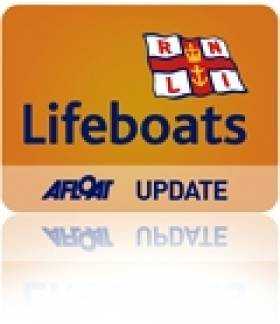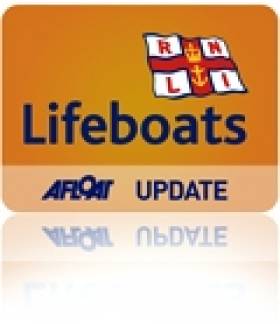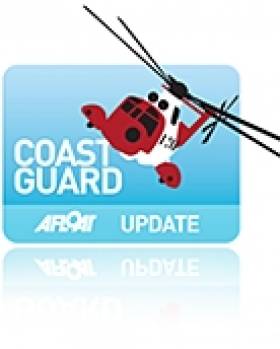Displaying items by tag: Courtmacsherry
Courtmacsherry RNLI Rescues Two In Early Morning Capsize
#RNLI - Two men were rescued in the early hours of this morning (Sunday 4 August) after their small boat got into difficulty off the pier at Courtmacsherry Harbour in West Cork.
Fourteen crew of the Courtmacsherry RNLI all-weather lifeboat station responded immediately to the Mayday call at 4.25am and the two casualties were pulled ashore from the water after the small boat which they were in capsized.
Following an 999 call from two local people, the Irish Coast Guard immediately tasked the Courtmacsherry lifeboat and the Shannon-based coastguard rescue helicopter.
Within minutes the small craft had overturned and the two young men on board were thrown into the water. Without delay, crew members and helpers succeeded in getting a lifebelt from the pierced to one of the casualties, while the other man was helped ashore at the pierhead.
The two men, both from Cork City, were said to be "shocked and traumatised" by their ordeal after they were brought back to the lifeboat station in Courtmacsherry to be assessed by station crew and officers. Conditions at sea this morning were good with little wind.
Courtmacsherry RNLI lifeboat operations manager Brian O'Dwyer said the men "had a very lucky escape in the early hours of this morning" and praised the fast response of the lifeboat crew members, local helpers and emergency services for "certainly averting a potential life threatening situation".
#lusitania – Courtmacsherry RNLI Lusitania Centenary Committee is appealing for artefacts, stories and memorabilia to be part of a major exhibition to commemorate the centenary of the sinking of the Lusitania off the Cork coast in 1915. They are also calling on any family members of those lost or saved in the Lusitania tragedy to contact them to share their stories, which will then be compiled and included in the exhibition.
The commemoration will be held on the May Bank holiday weekend 2015 with the centrepiece being a Lusitania Exhibition in Courtmacsherry RNLI Lifeboat Station and other local venues. Courtmacsherry lifeboat responded to the tragedy in 1915 and to coincide with the exhibition, the lifeboat crew will re-enact the call to service and row out to the site of the disaster.
Courtmacsherry RNLI Lifeboat Operations Manager, Brian O Dwyer said "This is an important event in our stations history. On the centenary of the tragic sinking of the Lusitania, the lifeboat crew will lay a wreath at the site of the disaster to commemorate the event and to remember those who lost their lives. The planned exhibition will be a special one for Courtmacsherry RNLI, as it is the sole remaining lifeboat station that responded to the sinking (Queenstown lifeboat crew also responded but the station was since closed). We are making this call early so that people can see if they have any Lusitania memorabilia or stories that they would like to be part of this exhibition."
The Lusitania was a British ocean liner, launched in 1907 by the Cunard line, a holder of the Blue Riband and briefly the world's biggest ship. On May 7th 1915 on passage from New York, she was torpedoed and sunk by a German U-boat South of Courtmacsherry Bay, West Cork, Ireland with the loss of over 1200 lives. Courtmacsherry RNLI Lifeboat, Ketzia Gwilt, which was then stationed at Barry's Point under the command of Coxswain Timothy Keohane (father of Antarctic explorer Patrick Keohane) and his crew of 14 men was tasked to respond to reports of a large four funnel steamer in distress South West of the Seven Heads. Courtmacsherry RNLI Lifeboat was launched, but in calm conditions, the sails were of no use so the entire distance of over 12 nautical miles to the casualty had to be rowed.
Courtmacsherry RNLI Lifeboat station has taken part in a major BBC documentary to be presented by renowned journalist, author and broadcaster Jeremy Paxman which will commemorate the centenary of World War 1. The sinking of the Lusitania was a significant event in drawing America into the war. The documentary is due to be aired in spring 2014.
Anyone with information or memorabilia for the exhibition is requested to please contact the Coxswain at Courtmacsherry RNLI Lifeboat Station at [email protected]. All memorabilia loaned for the exhibition will be returned.
Busy Times For RNLI At Courtmacsherry And Courtown
#RNLI - Courtmacsherry RNLI assisted two people after their yacht got into difficulty at the weekend.
The volunteer lifeboat crew was called out at 5.15pm on Saturday (13 July) to go to the aid of a yacht off Courtmacsherry Harbour in West Cork.
The all-weather lifeboat with a crew of six was underway within minutes and proceeded to the area where the casualty had developed mechanical failure. The lifeboat arrived on the scene in 10 minutes and proceeded to take the yacht with two people on board in tow.
Both the lifeboat and the stricken vessel were subsequently berthed at the pier in Courtmacsherry village.
This has been a busy week so far for Courtmacsherry RNLI with today's call-out being the fourth in five days.
The others were on Tuesday 9 July to an overdue jet ski in Clonakilty Bay, Thursday 11 July to the aid a windsurfer off Garrettstown, and Friday 12 July to a reported dingy off the Old Head of Kinsale which turned out to be a dead and upturned whale in the sea.
Elsewhere, Saturday was a busy evening for the Courtown lifeboat in Co Wexford.
- lifeboat was launched to a report of two vessels aground in a cove south of Courtown Harbour, quickly locating the vessels – a 15ft speedboat and a personal water craft (PWC) – just south of the harbour in the area known as Salt Rock.
There were two people with the vessels and the speedboat was grounded but swamped.
The lifeboat took both casualties, who were very cold, back to the harbour and then returned first to recover, bail out and tow the speedboat back, and then out to tow the PWC back into the harbour.
The lifeboat then returned to station and refuelled, ready for the Sea Sunday celebrations the following day.
#RNLI - Kilrush RNLI lifeboat station was put on standby on Monday 29 April for an aircraft with engine trouble, and later called to a person who drove into the water.
At 2pm on Monday the Irish Coast Guard at Shannon alerted the station authorities that there was a private aircraft descending in the region of the River Shannon with engine problems. It was reported that there were four people on board.
After a half an hour the lifeboat crew were informed the plane made a safe landing at Shannon Airport and the station was stood down.
Later that day at 8.47pm pagers were activated by the coastguard in Shannon to alert the crew that a person was reported to have driven off the road into the water in the area of Labasheeda, about nine nautical miles from Kilrush.
The lifeboat crew assembled and within eight minutes were launched and on their way to this area. Conditions on this evening were most favourable.
After five minutes they were stood down as members of the local Gardai had managed to rescue the driver and bring him ashore. An ambulance was standing by at this area to assist the casualty and team of helpers.
Kilrush lifeboat operations manager John Lamb praised the speed of the crew and the efficiency on which the launch took place.
“At times like these it’s always good to know that our team are trained to the highest standards to deal with callouts such as this evening,” he said.
In other news, President Michael D Higgins will pay a special call to Courtmacsherry RNLI lifeboat station this weekend during an official visit to the Cork village.
While there he will view an impressive historical exhibition which is running all through the May bank holiday weekend.
The exhibition, which has been planned for months, will have a strong emphasis on the lifeboat and its crew with most families in the village having had loved ones serving as volunteer lifeboat crew since 1825.
To mark this fact, local families have displayed the name of that lifeboat crew member outside their home and placed a pair of wellington boots on their doorstep. The yellow lifeboat boot is an iconic piece of the RNLI crew members' kit.
President Higgins is expected to arrive in Courtmacsherry at 4pm on Sunday 5 May and will first visit the lifeboat station where he will be met by volunteer lifeboat crew past and present and members of the station management and fundraisers.
The station has a proud history of lifesaving with 14 awards for gallantry.
Courtmacsherry RNLI launched after the sinking of the Lusitania in 1915 when the lifeboat crew rowed for over three hours in a desperate bid to reach survivors from the torpedoed vessel off the Old Head of Kinsale.
And during the Fastnet Race tragedy of 1979, in which 15 sailors lost their lives, the Courtmacsherry lifeboat was among of group of RNLI boats that spent 75 hours at sea in 60-knot winds.
At Courtmacsherry Harbour there is a pontoon at which overnight berthing is available for visiting vessels (a fee applies and payment can be made locally at the Pier House Bar). Facilities for boats at the pontoon include, electricity, water, fuel and domestic refuse facility.
Fisherman Dies Of Head Injuries Off Kinsale
#Coastguard - The Irish Times reports that a fisherman has died after sustaining head injuries in an incident off the Old Head of Kinsale last night.
The man, one of three crew on the West Cork-based fishing trawler Liberty, is believed to have died from his injuries on board the vessel.
According to TheJournal.ie, the Courtmacsherry RNLI lifeboat and Irish Coast Guard helicopters from Shannon (Rescue 115) and Waterford (Rescue 117) were all scrambled to the scene.
The deceased was airlifted by Rescue 117 to Cork for transfer to hospital, while the remaining crew returned to Kinsale this morning with the lifeboat crew.
It is thought that the accident involved trawling wires on board the fishing boat.
Divers Recovered from Lusitania Site After Boat Troubles
The Irish Times reports that the Courtmacsherry RNLI lifeboat went to the aid of divers at the wreck of the Lusitania yesterday.
The divers had been operating at the wreck site when their boat developed mechanical issues.
The lifeboat responded immediately in windy conditions and removed the crew to safety, towing the boat to Courtmacsherry.
As previously reported on Afloat.ie, divers led by the wreck's American owner hope to uncover the last big secrets of the stricken cruise liner, which was torpedoed by a German U-boat during the First World War.



































































